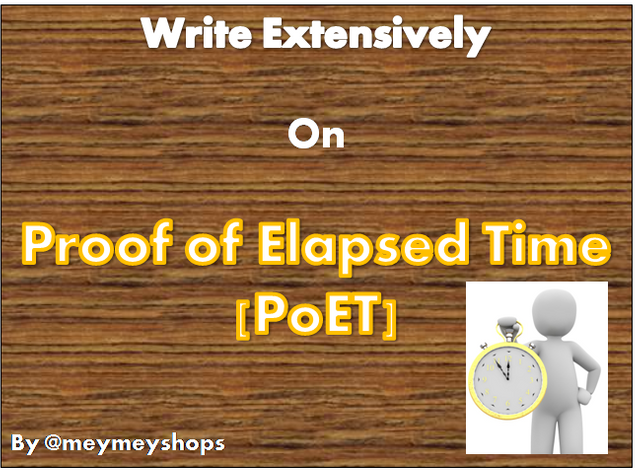SteemitCryptoAcademy Season 2 Week 5: Homework Task for @alphafx//Submitted by @meymeyshops//12/05/2021

Steemit Crypto Academy has become a necessary activity to me on weekly basis, I must confess my gratitude to this school of timely learning. Today participation is on:
Proof of Elapsed Time
Blockchain technology is expected to be versatile in building projects that can incorporate other sections other than cryptocurrency such as agriculture, medicine, manufacturing and transportation. Lots of blockchains have been developed but the problem of efficiency of performance still hovers around these numerous projects. It is on this premise of revolutionizing that Intel researchers came on board of designing a project that is not only efficient but also highly scalable.
In 2016, Intel researchers developed Proof of Elapsed Time as a private blockchain designed to be able to support a large pool of participants in a particular network. It is similar to Nakamoto style (Proof of Work) which has the goal of one CPU one vote but was not fully implemented. Proof of Elapsed Time is a time-lottery base consensus algorithm designed mainly to be used within the Intel products.
Methodology of PoET
While other algorithms use energy that can power a full house for many days, Proof of Elapsed Time manages energy resources efficiently. It does that by taking away the PoW's puzzle and tempering or softening the intensity of the mining hardware so that the hardware consumes less energy.
Again, PoET nominates leaders or controllers from among the participants, such nomination is dependent on the amount of staking positions of those members. So it is expected that members desirous of participating in the project must invest tangible or significant amount of money and time.
In other words, PoET creates an arena of trusted participants, elect a leader whose task majors on aggregating the work of participants and ensuring that they are correct. To achieve this task, once their work are aggregated, each enters a waiting period timed by a Stop Watch. The first to wake up or finishes earlier than others becomes the winner and is allowed to build a new block which is sent back to the leader who verifies its authenticity otherwise such block is thrown out. This process is repeated on and on.
The bedrock of Proof of Elapsed Time is Randomness. Generating of blocks are done in a swift of time with the Intel random number generating instruction called RDRAND and is perfected within the processor electrically. This is why it is called a lottery style because leaders are randomly selected.
PoET is user friendly as every computer with internet connection no matter the voltage, can participate in the project, this is made possible because its ability to efficiently utilize power. Nevertheless, participation demands that a valid certificate digitally generated by SGX (Software Guard Extension), is presented and verified for identification. At this point, the intending participant is given a time object and then becomes activated to participate.
Immediately the above stages are perfected, the generating phase ensues followed by hash tags. These processes are done by receiving transactions from the network, sending it back to the leader, generating hash with preferably SHA-256 and sending back to the leader for acceptability. All within a second. To put in simple terms: There is a waiting period before a user is allowed to generate a block. A generated new block must be backed up with a proof to verify the waiting time with the help of SGX.
Characteristics inherent to PoET
- Fairness: Every member among the participants is given equal right of opportunity to succeed
- Investment: Your staking position determines your level of participation
- Verification: There should no ambiguity or bottleneck barrier in verifying the elected controller.
Insecurities bedeviling PoET
Intel is notable for their inability to fix bugs even when it is obvious to users. One often hear of Meltdown, SGX crack, enclave and the like, all these and more prey on Intel products making many to trade with utmost caution on this project.
How bad is the situation?
Although there are risks everywhere but when a hardware like RDRAND becomes exposed to malware, it weakens, and the blocks to be generated becomes predictable such that a high-tech hacker can penetrate the system. When such happened, other trusted projects integrated on Intel PoET becomes compromised.
Conclusion
As we have seen above, Proof of Elapsed Time (PoET) is a blockchain by Intel, a well renowned software and hardware manufacturers but diversify with this concept in order to solve the problem of scalability and efficiency. It is primarily designed for private and licensed enterprises who desire their data or ledger be immutable which blockchain generally offers. PoET is a permissioned protocol with a bedrock of randomness yet there are a number of insecurities facing this project.
Thank you @alphafx for this privilege of learning in your esteemed tutelage.
well done, would have liked to see more details, and also comparisons between algorithms.
Thanks for participating
Thank you my brother, I will more better next time
Pls @alphafx, this post is now six days without curation can you please help out